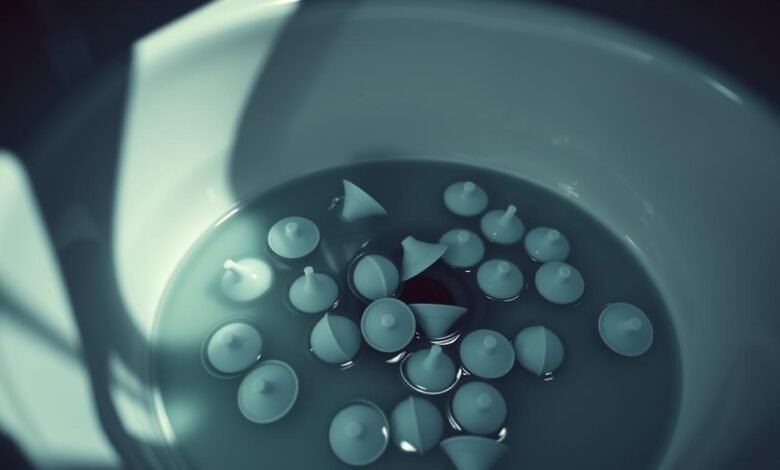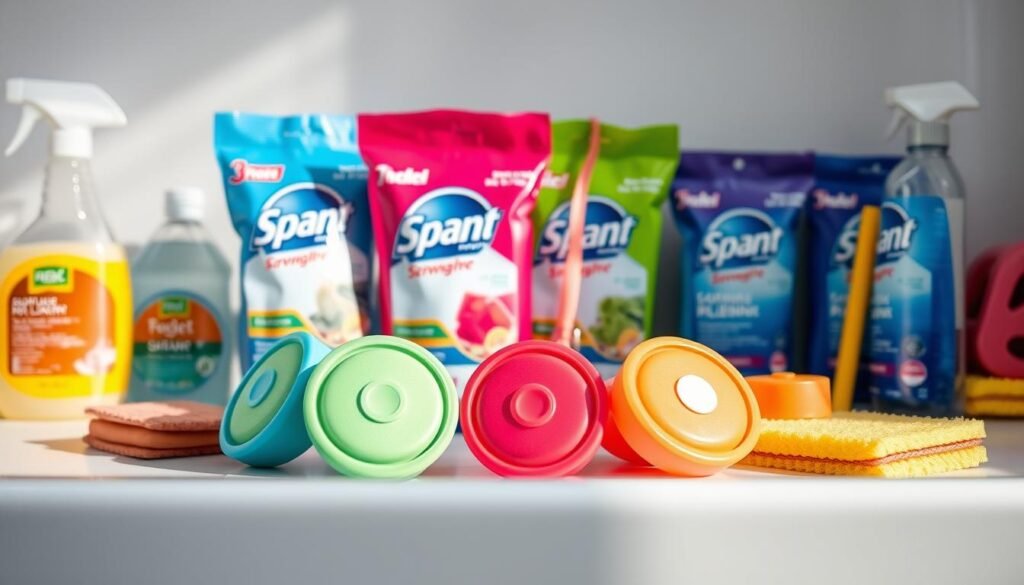
You want dishes that sparkle without risking a slow sink. So, does dishwasher pods clog drains? In most homes, no—when you use them the right way. The Spruce notes that pods are wrapped in polyvinyl alcohol (PVA), a film that dissolves in hot water during the wash. ZLINE appliance expert Alexis Novacek also emphasizes that proper fit and compatibility matter for smooth performance.
Yet, dishwasher pod drain clogging can happen if a pod doesn’t fully dissolve. Low water temperature, weak pressure, or bad placement may leave residue. This residue can mix with grease and food bits, leading to dishwasher pod plumbing issues you’d prefer to avoid.
This guide shows you how to prevent clogged drains with dishwasher pods. You’ll learn about the importance of heat, placement, and cycle time. You’ll also discover how to avoid drain clogs by choosing quality brands, loading pods correctly, and keeping your filter clean.
Key Takeaways
- High-quality pods with PVA film usually dissolve and do not clog drains when used as directed.
- Low water temperature or weak pressure can cause partial dissolution and residue.
- Correct pod placement and a compatible dispenser help prevent dishwasher pod plumbing issues.
- Hot cycles in the 120°F–150°F range improve dissolution and reduce buildup.
- Clean your dishwasher filter and avoid grease in the sink to limit residue sticking to pipes.
- If you notice film or undissolved bits, adjust heat and cycle length before switching brands.
What Dishwasher Pods Are and How They Dissolve in Your Machine
Dishwasher pods are single-use capsules that make cleaning easy. Just drop one in and let the cycle do the work. They help avoid spills and keep the cleaning steady, which is good for your dishwasher’s health.
Using them right also lowers the chance of clogs. The pod dissolves well if the water is hot, the spray is strong, and the door is closed. These are key steps to avoid clogs.
PVA film basics: the water‑soluble coating around pods
The pods have a thin, water-soluble wrap called PVA. It’s used in many products and dissolves in hot water. This lets the cleaning agents work during the wash.
Experts say PVA is safe but not fully biodegradable. The right placement of the pod in the detergent cup is important. It prevents early release and helps avoid clogs and drain issues.
What’s inside: concentrated detergents, enzymes, and water softeners
A pod contains concentrated detergents, enzymes, and water softeners. These work together to clean well. They target grease, sauces, and mineral spots.
This mix helps keep the drain healthy. A controlled dose means less residue, which is good for avoiding clogs.
How dissolution works during hot-water wash cycles
Dissolution starts when the pod meets hot water. The PVA film melts first, then the cleaning agents spread. The right placement, water temperature, and cycle time are key for full release.
If the pod is not placed correctly, it might dissolve too early. This can leave residue that causes drain problems. Using pods correctly ensures a clean wash without clogs.
does dishwasher pods clog drains
Do dishwasher pods clog drains? Most experts say no, if you use them right. The Spruce explains that putting the pod in the dispenser and making sure it fits well helps it dissolve properly.
Industry advice agrees. Better Homes & Gardens says the PVA film in pods is water-soluble. This means clogs are unlikely in normal use. Brands like Cascade and Finish are made to dissolve in hot water and rinse away.
But, problems can happen if conditions are not right. Cold water, weak spray, or short cycles can leave residue. Also, putting a pod in the tub instead of the dispenser can slow down its breakdown.
Choosing the right cycle and keeping water hot helps. This ensures the pod breaks down fully. It also helps avoid and prevent clogs in everyday use.
Key point: Use the dispenser, keep water temperature right, and choose reputable brands. This reduces the risk of clogs from dishwasher pods.
Common Reasons Pods Can Contribute to Drain Issues
When your cycle ends and the sink gurgles, it might mean a clog. Many dishwasher pod plumbing issues come from how they dissolve and rinse. Knowing the weak spots helps you fix problems early.
Partial dissolution from low water temperature or low pressure
Pods need hot water and steady flow to work right. If the water is too cold or the pressure is low, they don’t dissolve fully. This leaves behind sticky deposits that clog drains.
Residue build-up when running short or half loads
Quick washes and half loads cut down rinse time. This leaves surfactant film on dishes and in lines. Over time, it narrows passages, so regular maintenance is key.
Compatibility problems with certain pod films and newer, low-water dishwashers
Modern Energy Star models use less water. Some films don’t work well in these machines. This can lead to residue and clogs in tight plumbing paths.
Excess detergent from using more than one pod
Using two pods might seem like extra cleaning power. But, it can leave too much detergent in low-water cycles. This excess lingers as soap scum, trapping food particles. Regular maintenance is needed to keep lines clear.
Proper Dishwasher Pod Usage for Drain Health
Following best practices can protect your sink and dishwasher from clogs. Small changes in how you use dishwasher pods can make a big difference. This includes where you place the pod, the water temperature, and the cycle choice.
Always load pods in the detergent compartment that closes securely
Put the pod in the covered dispenser. This ensures it dissolves properly. The Spruce advises against putting the pod in the tub to avoid rewash.
Use one pod per cycle, which helps prevent clogs in low-water models.
Check pod size so the dispenser opens and releases on time
Make sure the pod fits your dispenser and the latch opens easily. Richard Novacek says an oversized pod can jam the door. Always check your owner’s manual for compatible pod sizes.
Run cycles hot enough: target 120°F–150°F inlet water
Most dishwasher pods work best in water between 120°F and 150°F. Cold water can prevent enzymes and films from dissolving. Hot water is key for proper pod usage and preventing clogs.
Choose cycles with adequate wash and rinse time for full dissolution
Choose a cycle with enough agitation and rinse volume. This ensures the pod breaks down completely. Longer wash cycles and full rinses help avoid leftover film and soap. This is important, even in newer, low-water dishwashers.
| Step | What to Do | Why It Helps | Brand/Manual Tip |
|---|---|---|---|
| Dispenser Placement | Load the pod in the covered compartment only | Ensures timed water contact for full dissolution | The Spruce warns against tossing pods in the tub |
| Pod Fit | Verify pod size so the door opens cleanly | Prevents jams and late release that leave residue | Novacek recommends checking dispenser clearance |
| Water Temperature | Target 120°F–150°F inlet water | Activates enzymes and dissolves PVA film | Cascade and Finish formulations perform best hot |
| Cycle Selection | Choose longer wash and full rinse | Removes leftover detergents before draining | Owner’s manuals specify optimal cycles |
| Dosage | Use one pod per cycle | Reduces buildup in low‑water machines | Prevents residue, aiding drain health |
Focus on these simple habits to keep avoiding drain clogs with dishwasher pods while maintaining proper dishwasher pod usage for drain health.
Drain Clog Prevention with Dishwasher Pods: Kitchen Maintenance Tips
Keep water flowing and odors away with simple habits. Focus on preventing clogs with dishwasher pods through smart prep, routine cleaning, and quick checks. These tips fit into your daily cooking and dish duties without extra hassle.
Pre-scrape food and keep grease out of the drain
Scrape off food before washing to avoid clogs. Wipe pans with a paper towel before washing. Don’t pour fats or oils down the sink. Cool them first and then throw them away as per local rules.
Clean the dishwasher filter to prevent debris-detergent buildup
Remove and rinse the filter under warm water weekly if you cook a lot. A clean filter stops crumbs from mixing with pod residue. This simple task keeps your drain flowing well.
Periodically run a cleaning cycle to clear soap and film
Run a hot cleaning cycle with a dishwasher cleaner once a month. For a DIY option, use white vinegar on the top rack, then a short cycle with baking soda. This routine keeps your drain clear of film.
Inspect plumbing and air gaps if drainage slows
If water stays in the tub, check the air gap and drain hose loop. Clearing the air gap cap or disposal port can fix the issue. Store pods in a cool, dry place to prevent clumping.
Dishwasher pod disposal tips are important too. Toss empty wrappers and damaged pods in trash, and never flush them down the drain. This keeps your plumbing clear and prevents clogs.
| Habit | Why It Helps | How Often | Pro Pointer |
|---|---|---|---|
| Pre-scrape food, keep grease out | Reduces residue binding that can slow drains | Every load | Wipe pans before loading; cool and seal used oil for trash |
| Clean dishwasher filter | Stops debris-detergent buildup in the drain path | Weekly to biweekly | Re-seat filter snugly to maintain spray pressure |
| Run cleaning cycle | Clears soap film and mineral deposits | Monthly | Use Finish, Affresh, or a vinegar then baking soda routine |
| Inspect air gap and hose | Restores flow if drainage slows | As needed | Confirm a high drain hose loop above the disposal inlet |
| Store pods correctly | Prevents clumping that affects dissolution | Ongoing | Keep in a cool, dry, airtight bin away from steam |
| Follow disposal tips | Keeps non-dissolving waste out of plumbing | Every use | Trash damaged pods and empty films; never flush |
Choosing Quality Pods and Compatible Products

Choosing the right dishwasher pods can help avoid clogs. Look for pods made for low-water machines. Brands like Cascade, Finish, and Seventh Generation make films that dissolve in stages. This reduces residue and prevents clogs.
Make sure the pod fits your dishwasher model and age. Check your owner’s manual and follow the manufacturer’s instructions. If your plumbing is old or has tight bends, fast-dissolving pods are a good choice.
Some pods come with a rinse aid to improve drying. If your pods don’t have one, add a separate rinse aid from a trusted brand like Finish Jet-Dry. Good rinse action helps clear film and prevents clogs.
Be careful with environmental claims. The Spruce reports that PVA is not fully biodegradable and can break into microplastics. Better Homes & Gardens says the EPA considers PVA safe but not fully biodegradable. Choose products that balance cleaning, compatibility, and sustainability.
Aim for steady performance over hype: pick reputable formulas, confirm compatibility, and support clear rinsing to avoid dishwasher pod clogging.
| Brand Example | Film/Dissolution Notes | Rinse Aid Option | Best Fit | Drain-Friendly Tip |
|---|---|---|---|---|
| Cascade Platinum | Multi-layer PVA film designed for quick release in low-water cycles | Built-in rinse aid in many SKUs | Modern Energy Star dishwashers | Use one pod per load to support preventing clogged drains with dishwasher pods |
| Finish Quantum | Staged dissolution for enzymes and surfactants | Jet-Dry available separately | Mixed households with hard water | Add separate rinse aid to reduce dishwasher pod drain issues |
| Seventh Generation | Plant-based surfactants with water-soluble film | Rinse aid sold separately | Eco-focused users | Confirm full-hot cycle to minimize dishwasher pod clogging |
| Ecover | Rapid-dissolving design for shorter cycles | Separate rinse aid available | Quick-wash routines | Verify dispenser fit as part of best practices for using dishwasher pods without clogging drains |
Troubleshooting Dishwasher Pod Drain Clogs
Watch how each cycle ends to spot dishwasher pod plumbing issues early. Look for signs on the dishes, in the tub, and in the dispenser. Quick action helps prevent drain clogs and reduces the risk of clogging.
Signs of partial dissolution: residue in dispenser or on dishes
Undissolved detergent in the dispenser or a chalky film on glassware are signs of a problem. You might also see a slimy ring in the tub. These symptoms often mean dishwasher pod plumbing issues and can lead to clogs if ignored.
What to do if pods don’t dissolve: heat, cycle selection, water pressure checks
First, make sure the pod fits in the detergent cup without binding. Increase the water temperature to 120°F–150°F. Choose a longer, hotter cycle to improve wash and rinse times.
If spray arms sputter or glasses spot, test the water pressure. Clear the filter and air gap. These steps help fix dishwasher pod drain clogs and prevent future issues.
When to switch pod brands or formats
If residue persists after trying heat and cycle changes, consider a different pod brand. Try Cascade or Finish, or switch to liquid or powder. This change can help in hard water or with newer machines.
When to call a pro for persistent slow drains
Slow drainage, gurgling, or foul odors mean a big blockage. Grease, food debris, or an aging P-trap can cause problems. If adjustments don’t work, call a licensed plumber or appliance technician to check the line and pump.
| Symptom | Likely Cause | Home Step | When to Seek Help |
|---|---|---|---|
| Detergent left in dispenser | Pod jam or low water heat | Confirm pod fit; raise inlet to 120°F–150°F | If residue returns after multiple cycles |
| Chalky film on dishes | Partial dissolution or hard water | Select longer, hotter wash; try different brand or powder | If film persists across brands and settings |
| Slimy tub residue | Detergent buildup mixed with grease | Clean filter and run a hot cleaning cycle | If slime returns and drain slows |
| Slow draining, gurgling | Line obstruction or aging plumbing | Check air gap and hose for kinks | If water backs up into sink or persists |
| Spotty glasses, weak spray | Low water pressure or clogged arms | Clear spray arms; verify pressure | If pressure is normal yet issues remain |
Environmental and Plumbing Considerations

You want clean dishes and clear pipes, but you also care about what goes down the drain. Understanding materials, placement, and alternatives is key. These tips help prevent drain clogs and keep your footprint low. They also reduce wear on your machine over time.
PVA is water‑soluble but not fully biodegradable; what that means
Most pods use PVA film that dissolves in hot water, helping it flow through plumbing. But, research shows it’s not fully biodegradable. It can stay as microplastics in air, water, and soil.
The EPA says PVA is safe, but it doesn’t completely disappear. To reduce environmental impact, use water between 120°F–150°F. Also, run complete cycles for full dissolution.
Why correct placement matters for both plumbing and appliance health
Putting a pod in the sealed detergent compartment ensures it releases at the right time. This way, enzymes and surfactants work during wash and rinse. Misplacing a pod or using more than one can cause residue buildup.
Following best practices can prevent drain issues and protect your dishwasher. Check out independent guidance for more tips.
Alternatives: liquid or powder detergents and proper disposal tips
If you see film or undissolved bits, think about switching to liquid or powder detergent. These types disperse quickly in modern machines. Store pods airtight and dry to prevent clumping.
Recycle packaging where accepted. These tips, along with using hot water and full rinses, help prevent clogs. They also follow best practices for using dishwasher pods.
Best Practices for Using Dishwasher Pods Without Clogging Drains
Always use one pod per load and place it in the detergent compartment that closes and clicks shut. Make sure the latch opens freely during the cycle. This is key for drain health. If a pod seems tight or jammed, it may not release on time and can leave residue.
Check if the pod size matches your model’s dispenser. If it doesn’t fit, choose a smaller format or switch to liquid or powder from brands like Cascade or Finish. This step helps avoid drain clogs by ensuring full release and rinse.
Run hot enough water—aim for 120°F to 150°F at the inlet—to help dissolve the film. Choose cycles with enough wash and rinse time if you notice film on the door or dishes. These practices reduce undissolved bits that can collect in traps.
Pre-scrape plates and keep grease out of the sink to prevent sticky buildup downstream. Clean the dishwasher filter regularly and run a monthly cleaning cycle. These steps keep flow steady and help your dishwasher work as designed.
Store pods in a cool, dry, airtight container, as recommended by Better Homes & Gardens, to prevent clumping that can block dispensing. If residue persists after hot cycles, check water pressure, try a different pod brand or move to liquid or powder, and review your appliance guidance before calling a technician.
Quick reminder: Even placement, correct size, and hot water work together. Keep to one pod, keep grease out, and keep filters clean for proper dishwasher pod usage for drain health.
| Action | Why It Matters | What to Watch | Next Step If Issues Persist |
|---|---|---|---|
| Load one pod in the closing dispenser | Ensures timed release and full dissolve | Latch clicks shut and opens mid-cycle | Replace broken latch; use correct pod size |
| Match pod size to your model | Prevents jams that leave residue | Pod fits without force | Switch to smaller pods or liquid/powder |
| Run 120°F–150°F inlet water | Promotes full film dissolution | No soap film on door or utensils | Select longer, hotter cycles; check heater settings |
| Pre-scrape food and keep grease out | Reduces sticky buildup in filters and drains | Clear filter after several loads | Rinse filter and wipe seals; avoid pouring fats in sink |
| Store pods airtight in a dry spot | Prevents clumping that hinders dispensing | Pods are free-flowing, not stuck together | Replace moisture-exposed pods; refresh container |
| Evaluate brand and water pressure if residue remains | Optimizes dissolve and rinse performance | Steady spray arms and clean sprayer holes | Try Cascade or Finish alternatives; consult a pro for slow drains |
Conclusion
Using pods safely means matching them to your machine’s needs. The Spruce says pods are fine if used correctly. Better Homes & Gardens adds that PVA films, found in some pods, are safe for dishwashers.
The big question is whether pods can clog drains. It really depends on how you use them, the water temperature, and how well you maintain your dishwasher.
The main problems are when pods don’t fully dissolve, leave too much detergent, or trap grime. To avoid this, make sure the water is hot enough, use only one pod per load, and choose long enough cycles. Also, clean the filter, scrape off food before washing, and run a cleaner now and then.
For more on PVA and safe use, see this brief from Better Homes & Gardens.
If you’re facing clogs, try changing pod brands or using liquid or powder detergent. Also, check your water pressure and plumbing. By following these tips, you can keep your drains clear and your dishes sparkling.



